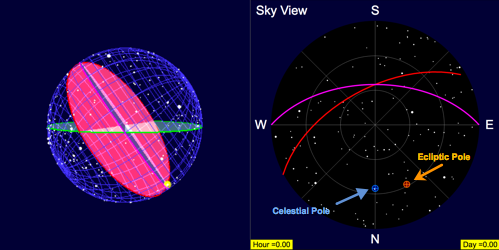
General Description
This program simulates the Two Sphere Universe theory of the Ancient Greeks. This theory
supposes the stars to be fixed on the surface of a Celestial Sphere, with
the spherical Earth at the center of this sphere. The simulation shows the motion of Sun
and stars in this model, as well as the horizon plane for an observer on the spherical
Earth. Two views are shown: one from outside the Celestial Sphere, and the other showing
the Sky View as seen by an observer on Earth facing North and looking up. Most of the
characteristics of the simulation can be adjusted, including the latitude of the
observer, the time of day, the time of year, the tilt of Earth's rotational axis
relative to the ecliptic plane, and the eccentricity of Earth's orbit. You can also
change the calendar year (the default is 2000 AD) to see the precession of the
equinoxes.
The program simulates the motion of the true Sun which does not move through the stars at
a uniform rate because of Earth's elliptical orbit. An option changes the simulation to
use a Sun that moves uniformly along the ecliptic.
Display
- Main Options
- Trace Sun: Trace of Sun's path.
- Celestial Grid: Show lines of constant RA and Dec (including the celestial
equator and meridian).
- Ecliptic: Show the ecliptic plane.
- Horizon: Show the observer's horizon plane.
- Equator: Show the plane of the celestial equator.
- Horizon: Show the observer's horizon plane.
- Extra Opts. Displays extra controls for adjusting the number of days per
year, the tilt of Earth's axis, the eccentricity of Earth's orbit, and the
year (to see the effects of precession).
- Extra Options
- Stars: show points representing stars.
- Celestial Axis: show the celestial axis.
- Ecl. Axis: show the axis or Earth's orbit around Sun.
- Ecl. Grid: show lines of constant ecliptic longitude and latitude.
- Local Grid: if checked, lines of constant altitude and azimuth will be
shown.
- Uniform: Use a Sun that moves uniformly along the ecliptic.
- Labels: Shows and hides labels in the Sky View.
- Year: Controls the calendar year (Gregorian calendar). Change the year to
demonstrate the effects of precession.
- Axial Tilt: Controls the tilt of Earth's rotational axis relative to the
axis of its orbit. The real value is 23.5 degrees. If the stars are fixed
relative to the ecliptic (which is the default) then they will not move as
the tilt is changed. If the stars are fixed relative to the Celestial
Equator then they will move with the axis.
- Eccentricity: Controls the eccentricity of Earth's orbit. The real value is
0.0167. Note that increasing the eccentricity may cause the Select Day
options to not function properly (because, for example, the summer solstice
may no longer be very close to Time of Year = 0.252).
- Visual Elements
- Yellow sphere: Sun.
- White dots: stars. The simulation shows the 300 brightest stars, with
positions taken from the Bright Star Catalog.
- Red circle: The ecliptic plane. (Red trail in Sky View.)
- Magenta circle: The plane of the celestial equator. (Magenta trail in Sky
View.)
Controls
- Play/Pause: Start and stop the simulation.
- Step: Advance the simulation forward by one time step.
- Reset Time: Reset the simulation without changing parameter values.
- Reset: Reset simulation to original state.
- Erase: Clear the traces showing the Sun's motion.
- Mode radio buttons: Select the time of day or the time of year mode.
- Day mode: Time slider adjusts the time of day measured in hours. Run advances the
time of day.
- Year mode: Time slider adjusts the time of year measured in 24 hour days. The vernal
equinox is 0, the summer solstice is about 0.252 year, the autumnal equinox
is 0.507 year, and the winter solstice is 0.756 year.
- Latitude slider: Sets the latitude (deg N) of the observer's location. For southern
latitudes use negative values.
- Select Day
- Vernal Equinox (Time of Year = 0)
- Summer Solstice (Time of Year = 0.252)
- Autumnal Equinox (Time of Year = 0.507)
- Winter Solstice (Time of Year = 0.756)
Credits:
Celestial Sphere and Analemma model was developed by Wolfgang
Christian and Todd Timberlake using the Easy Java Simulations (EJS) version 5 authoring
and modeling tool. Information about EJS is available at: <http://www.um.es/fem/Ejs/> and in
the OSP ComPADRE collection <http://www.compadre.org/OSP/>.
Todd K. Timberlake (ttimberlake@berry.edu)
Wolfgang Christian (wochristian@davidson.edu)
